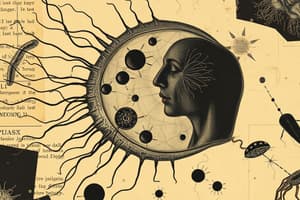Podcast
Questions and Answers
What type of organisms are protozoa?
What type of organisms are protozoa?
- Unicellular prokaryotic
- Unicellular eukaryotic (correct)
- Multicellular eukaryotic
- Multicellular prokaryotic
What characteristic do protozoa lack?
What characteristic do protozoa lack?
- Cell wall (correct)
- Mitochondria
- Cytoplasm
- Nucleus
Which protozoan is known to cause malaria?
Which protozoan is known to cause malaria?
- Trichomonas
- Plasmodium (correct)
- Trypanosoma
- Euglena
How many species of protozoans are there approximately?
How many species of protozoans are there approximately?
Which function is performed by different cell organelles in protozoa similar to higher animals?
Which function is performed by different cell organelles in protozoa similar to higher animals?
What is the function of the central vacuole in cellular structure?
What is the function of the central vacuole in cellular structure?
Which type of nucleus do ciliates possess?
Which type of nucleus do ciliates possess?
Which of these structures is responsible for locomotion in cells?
Which of these structures is responsible for locomotion in cells?
What is a pellicle?
What is a pellicle?
Which protozoans' nucleoli contain DNA?
Which protozoans' nucleoli contain DNA?
Flashcards are hidden until you start studying
Study Notes
Characteristics of Protozoa
- Protozoa are unicellular, eukaryotic, and heterotrophic organisms.
- They can be either free-living or parasites.
- There are approximately 65,000 species of protozoans, categorized into different groups.
- They lack a cell wall.
Cellular Structure
- Protozoa have a eukaryotic cell with a single membrane-bound nucleus.
- The nucleus has a diffused appearance due to scattered chromatin, and contains a central body called endosome or nucleoli.
- Nucleoli of apicomplexans have DNA, whereas those of amoeboid protozoa lack DNA.
- Ciliates have both micronucleus and macronucleus.
- The plasma membrane encloses the cytoplasm and locomotory projections like flagella, pseudopodia, and cilia.
Cell Organelles and Structures
- Some protozoa have a membranous envelope called pellicle, which gives a definite shape to the cell.
- Epibiotic bacteria can attach to the pellicle by their fimbriae in some protozoans.
- The cytoplasm is differentiated into outer ectoplasm and inner endoplasm, with ectoplasm being transparent and endoplasm containing cell organelles.
- Some protozoa have a cytostome for ingesting food, and food vacuoles where ingested food is stored.
- Ciliates have a gullet, a body cavity that opens outside.
- A central vacuole is present in some protozoa for osmoregulation, removing excess water.
- Membrane-bound cell organelles, such as mitochondria, Golgi bodies, lysosomes, and other specialized structures, are present.
Pathogenic Protozoa
- Some protozoa cause diseases in animals and humans, such as Plasmodium (malaria), Trypanosoma (sleeping sickness), and Trichomonas (trichomoniasis).
Studying That Suits You
Use AI to generate personalized quizzes and flashcards to suit your learning preferences.



